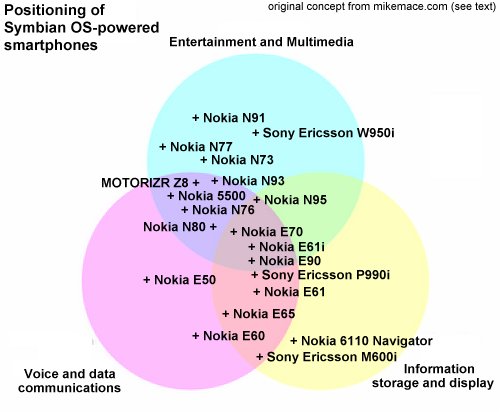Here's Michael's original piece, for reference: http://mobileopportunity.blogspot.com/2007/01/shape-of-smartphone-and-mobile-data.html
I tweaked and expanded the categories slightly and used all the current and upcoming Symbian OS-powered devices. Let's see how their strengths fit into the chart:

Just as with Michael's original generic analysis, the 'Information storage and display'-only section is rather bare, but this perhaps reflects that quite a few of the devices on the chart (e.g. the Nokia E61/E61i/E90) are also pretty darned good at addressing communications and multimedia.
The four UIQ 3 smartphones are interesting in that they're positioned well apart from each other - canny design and marketing?
Especially interesting is that in Michael's chart, he referred to the central shaded area as the 'zone of death', concluding that no devices can successfully address all three categories. It's true that sales figures for the Nokia E70, E61i and E90 are unlikely to be astronomic (compared to, say, the mass-market Nokia E65, N80 or N76), so maybe he's got a point. But people who do buy these central devices are likely to be fairly influential, classic early adopters, bloggers (just witness the number of E61 blogs), journalists and high-profile professionals, generating a lot of buzz around the Internet and office.
The generally more converged nature of Symbian OS-powered smartphones is of course evident as well, as is the overall positioning split at Nokia between their Nseries and Eseries devices.
Steve Litchfield, 18 Feb 2007

 Remembering Michael Mace's excellent generic positioning (in the handheld industry) diagram from last year, I wondered where the current and upcoming crop of Symbian OS-powered hardware might sit in his Entertainment/Communications/Information chart. Comments are welcome as always.
Remembering Michael Mace's excellent generic positioning (in the handheld industry) diagram from last year, I wondered where the current and upcoming crop of Symbian OS-powered hardware might sit in his Entertainment/Communications/Information chart. Comments are welcome as always.